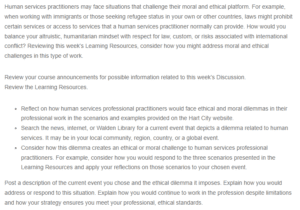Ethical Dilemma For Human Service Practitioners
Working with refugees and immigrants presents several ethical dilemmas for human service practitioners. The difficulty can emerge from social and cultural issues such as the language of communication and lack of knowledge of one’s culture (Berlinger, 2019). However, while this is an ethical dilemma, another serious one is caused by the prevailing laws and policies shrouding immigrants (Berlinger, 2019). Different eras of leadership come up with policies that guide how undocumented immigrants in the United States of America should be treated. The Trump Administration, for instance, considered undocumented immigrants as unworthy of receiving government services since they live in the country illegally. Since his administration, some of his policies have not been lifted, and even though the present government is slightly lenient to immigrants, some of these policies still prevail.
Policies that limit the services to immigrants present ethical dilemmas to human service practitioners Greenberg et al., (2012). For instance, a medical practitioner offering healthcare in a public facility may face the moral dilemma of providing adequate and necessary care to an undocumented immigrant or choosing not to give such care. This situation presents a hole in two ways. Firstly, it presents a dilemma because the clinician’s primary duty is to offer the best healthcare, yet there are legal requirements to the limits they should offer. Greenberg et al. (2012) present a case like this, thus reaffirming that such scenarios create moral challenges for the practitioner. Another instance is when a human service practitioner deals with child abuse cases among undocumented immigrants. A practitioner overwhelmed with other duties may overlook such cases and not help the child because the law limits how much they can do regarding undocumented immigrants (Greenberg et al., 2012). Some states have come up with laws when dealing with children of undocumented immigrants. Yet, these laws vary, allowing the practitioner to act in a way that may be considered biased, thus creating an ethical challenge.
Balancing an altruistic, humanitarian mindset concerning law, customs, or risks associated with international conflict is very difficult. In such scenarios, the best approach is to apply value ethics by taking an action based on the moral philosophy that would be applicable at the time. For instance, one may choose to use deontology, virtue ethics, or any of the six philosophies that would be applicable. In most cases, one should undertake an action for the greater good. This means that the action may also include going against the law, the customs, and undertaking risks to do what is right.
References
Is it ethical to bend the rules for undocumented and other immigrant patients? (2019). AMA Journal of Ethics, 21(1). https://doi.org/10.1001/amajethics.2019.100
Mark Greenberg, R. C. (2021, November 9). Immigrant families and child welfare systems: Emerging needs and promising policies. migrationpolicy.org. Retrieved January 19, 2023, from https://www.migrationpolicy.org/research/immigrant-families-child-welfare-systems
ORDER A PLAGIARISM-FREE PAPER HERE
We’ll write everything from scratch
Question 
Human services practitioners may face situations that challenge their moral and ethical platform. For example, when working with immigrants or those seeking refugee status in your own or other countries, laws might prohibit certain services or access to services that a human services practitioner normally can provide. How would you balance your altruistic, humanitarian mindset with respect for law, custom, or risks associated with international conflict? Reviewing this week’s Learning Resources, consider how you might address moral and ethical challenges in this type of work.

Ethical Dilemma For Human Service Practitioners
Review your course announcements for possible information related to this week’s Discussion.
Review the Learning Resources.
- Reflect on how human services professional practitioners would face ethical and moral dilemmas in their professional work in the scenarios and examples provided on the Hart City website.
- Search the news, internet, or Walden Library for a current event that depicts a dilemma related to human services. It may be in your local community, region, country, or a global event.
- Consider how this dilemma creates an ethical or moral challenge to human services professional practitioners. For example, consider how you would respond to the three scenarios presented in the Learning Resources and apply your reflections on those scenarios to your chosen event.
Post a description of the current event you chose and the ethical dilemma it imposes. Explain how you would address or respond to this situation. Explain how you would continue to work in the profession despite limitations and how your strategy ensures you meet your professional, ethical standards.